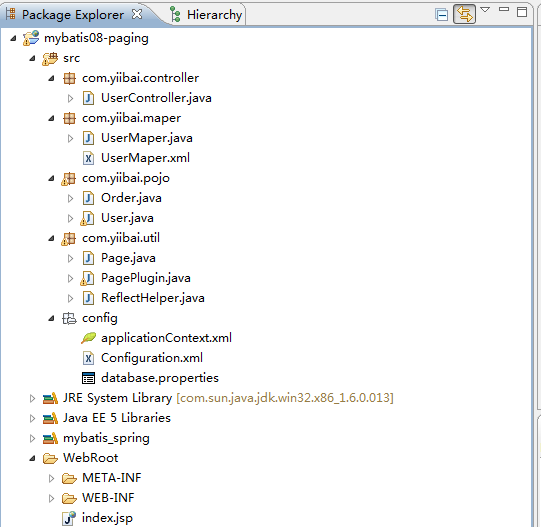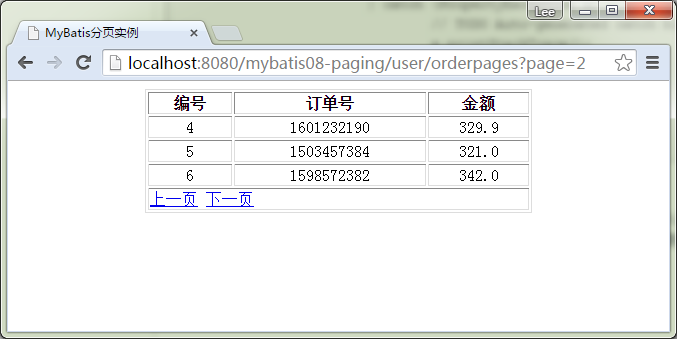MyBatis分頁
1、範例功能描述
2、建立工程
3、資料庫表結構及資料記錄
4、範例物件
5、組態檔案
6、測試執行,輸出結果
1、範例功能描述
在本範例中,需要使用 MyBatis和Spring MVC整合完成分頁,完成這樣的一個簡單功能,即指定一個使用者(ID=1),查詢出這個使用者關聯的所有訂單分頁顯示出來(使用的資料庫是:MySQL)。
2、建立工程
首先建立一個工程的名稱為:mybatis08-paging,在 src 原始碼目錄下建立檔案夾 config,並將原來的 mybatis 組態檔案 Configuration.xml 移動到這個檔案夾中, 並在 config 文家夾中建立 Spring 組態檔案:applicationContext.xml。工程結構目錄如下:

3、資料庫表結構及資料記錄
在本範例中,用到兩個表:使用者表和訂單表,其結構和資料記錄如下:
CREATE TABLE `user` (
`id` int(10) unsigned NOT NULL AUTO_INCREMENT,
`username` varchar(64) NOT NULL DEFAULT '',
`mobile` varchar(16) NOT NULL DEFAULT '',
PRIMARY KEY (`id`)
) ENGINE=InnoDB AUTO_INCREMENT=3 DEFAULT CHARSET=utf8;
-- ----------------------------
-- Records of user
-- ----------------------------
INSERT INTO `user` VALUES ('1', 'yiibai', '13838009988');
INSERT INTO `user` VALUES ('2', 'saya', '13838009988');
訂單表結構和資料如下:
CREATE TABLE `order` (
`order_id` int(10) unsigned NOT NULL AUTO_INCREMENT,
`user_id` int(10) unsigned NOT NULL DEFAULT '0',
`order_no` varchar(16) NOT NULL DEFAULT '',
`money` float(10,2) unsigned DEFAULT '0.00',
PRIMARY KEY (`order_id`)
) ENGINE=InnoDB AUTO_INCREMENT=17 DEFAULT CHARSET=utf8;
-- ----------------------------
-- Records of order
-- ----------------------------
INSERT INTO `order` VALUES ('1', '1', '1509289090', '99.90');
INSERT INTO `order` VALUES ('2', '1', '1519289091', '290.80');
INSERT INTO `order` VALUES ('3', '1', '1509294321', '919.90');
INSERT INTO `order` VALUES ('4', '1', '1601232190', '329.90');
INSERT INTO `order` VALUES ('5', '1', '1503457384', '321.00');
INSERT INTO `order` VALUES ('6', '1', '1598572382', '342.00');
INSERT INTO `order` VALUES ('7', '1', '1500845727', '458.00');
INSERT INTO `order` VALUES ('8', '1', '1508458923', '1200.00');
INSERT INTO `order` VALUES ('9', '1', '1504538293', '2109.00');
INSERT INTO `order` VALUES ('10', '1', '1932428723', '5888.00');
INSERT INTO `order` VALUES ('11', '1', '2390423712', '3219.00');
INSERT INTO `order` VALUES ('12', '1', '4587923992', '123.00');
INSERT INTO `order` VALUES ('13', '1', '4095378812', '421.00');
INSERT INTO `order` VALUES ('14', '1', '9423890127', '678.00');
INSERT INTO `order` VALUES ('15', '1', '7859213249', '7689.00');
INSERT INTO `order` VALUES ('16', '1', '4598450230', '909.20');
4、範例物件
使用者表和訂單表分別對應兩個範例物件,分別是:User.java 和 Order.java,它們都在 com.yiibai.pojo 包中。
User.java程式碼內容如下:
package com.yiibai.pojo;
import java.util.List;
/**
* @describe: User
* @author: Yiibai
* @version: V1.0
* @copyright https://www.tw511.com
*/
public class User {
private int id;
private String username;
private String mobile;
public int getId() {
return id;
}
public void setId(int id) {
this.id = id;
}
public String getUsername() {
return username;
}
public void setUsername(String username) {
this.username = username;
}
public String getMobile() {
return mobile;
}
public void setMobile(String mobile) {
this.mobile = mobile;
}
}
Order.java程式碼內容如下:
package com.yiibai.pojo;
/**
* @describe: User - 訂單
* @author: Yiibai
* @version: V1.0
* @copyright https://www.tw511.com
*/
public class Order {
private int orderId;
private String orderNo;
private float money;
private int userId;
private User user;
public int getUserId() {
return userId;
}
public void setUserId(int userId) {
this.userId = userId;
}
public int getOrderId() {
return orderId;
}
public void setOrderId(int orderId) {
this.orderId = orderId;
}
public User getUser() {
return user;
}
public void setUser(User user) {
this.user = user;
}
public String getOrderNo() {
return orderNo;
}
public void setOrderNo(String orderNo) {
this.orderNo = orderNo;
}
public float getMoney() {
return money;
}
public void setMoney(float money) {
this.money = money;
}
}
5、組態檔案
這個範例中有三個重要的組態檔案,它們分別是:applicationContext.xml , Configuration.xml 以及 UserMaper.xml。
applicationContext.xml 組態檔案裡最主要的組態:
<?xml version="1.0" encoding="utf-8"?>
<beans xmlns="http://www.springframework.org/schema/beans"
xmlns:xsi="http://www.w3.org/2001/XMLSchema-instance" xmlns:aop="http://www.springframework.org/schema/aop"
xmlns:tx="http://www.springframework.org/schema/tx" xmlns:context="http://www.springframework.org/schema/context"
xmlns:p="http://www.springframework.org/schema/p"
xsi:schemaLocation="
http://www.springframework.org/schema/beans http://www.springframework.org/schema/beans/spring-beans-3.0.xsd
http://www.springframework.org/schema/aop http://www.springframework.org/schema/aop/spring-aop-3.0.xsd
http://www.springframework.org/schema/context http://www.springframework.org/schema/context/spring-context-3.0.xsd
http://www.springframework.org/schema/jee http://www.springframework.org/schema/jee/spring-jee-3.0.xsd
http://www.springframework.org/schema/tx http://www.springframework.org/schema/tx/spring-tx-3.0.xsd"
default-autowire="byName" default-lazy-init="false">
<!--本範例採用DBCP連線池,應預先把DBCP的jar包複製到工程的lib目錄下。 -->
<context:property-placeholder location="classpath:/config/database.properties" />
<bean id="dataSource" class="org.apache.commons.dbcp.BasicDataSource"
destroy-method="close" p:driverClassName="com.mysql.jdbc.Driver"
p:url="jdbc:mysql://127.0.0.1:3306/yiibai?characterEncoding=utf8"
p:username="root" p:password="" p:maxActive="10" p:maxIdle="10">
</bean>
<bean id="transactionManager"
class="org.springframework.jdbc.datasource.DataSourceTransactionManager">
<property name="dataSource" ref="dataSource" />
</bean>
<bean id="sqlSessionFactory" class="org.mybatis.spring.SqlSessionFactoryBean">
<!--dataSource屬性指定要用到的連線池-->
<property name="dataSource" ref="dataSource" />
<!--configLocation屬性指定mybatis的核心組態檔案-->
<property name="configLocation" value="classpath:config/Configuration.xml" />
<!-- 所有組態的mapper檔案 -->
<property name="mapperLocations" value="classpath*:com/yiibai/mapepr/*.xml" />
</bean>
<bean class="org.mybatis.spring.mapper.MapperScannerConfigurer">
<property name="basePackage" value="com.yiibai.maper" />
</bean>
</beans>
組態檔案 Configuration.xml 的內容如下:
<?xml version="1.0" encoding="UTF-8" ?>
<!DOCTYPE configuration PUBLIC "-//mybatis.org//DTD Config 3.0//EN"
"http://mybatis.org/dtd/mybatis-3-config.dtd">
<configuration>
<typeAliases>
<typeAlias alias="User" type="com.yiibai.pojo.User"/>
<typeAlias alias="Order" type="com.yiibai.pojo.Order"/>
</typeAliases>
<!-- 與spring 整合之後,這些可以完全刪除,資料庫連線的管理交給 spring 去管理 -->
<!--
<environments default="development">
<environment id="development">
<transactionManager type="JDBC"/>
<dataSource type="POOLED">
<property name="driver" value="com.mysql.jdbc.Driver"/>
<property name="url" value="jdbc:mysql://127.0.0.1:3306/mybatis?characterEncoding=utf8" />
<property name="username" value="root"/>
<property name="password" value="password"/>
</dataSource>
</environment>
</environments>
-->
<!-- 這裡交給sqlSessionFactory 的 mapperLocations屬性去得到所有組態資訊 -->
<!--
<mappers>
<mapper resource="com/yihaomen/mapper/User.xml"/>
</mappers>
-->
</configuration>
UserMaper.xml 用於定義查詢和資料物件對映,其內容如下:
<?xml version="1.0" encoding="UTF-8" ?>
<!DOCTYPE mapper PUBLIC "-//mybatis.org//DTD Mapper 3.0//EN"
"http://mybatis.org/dtd/mybatis-3-mapper.dtd">
<mapper namespace="com.yiibai.maper.UserMaper">
<!-- 為了返回list 型別而定義的returnMap -->
<resultMap type="User" id="resultUser">
<id column="id" property="id" />
<result column="username" property="username" />
<result column="mobile" property="mobile" />
</resultMap>
<!-- User 聯合 Order 查詢 方法的組態 (多對一的方式) -->
<resultMap id="resultUserOrders" type="Order">
<id property="orderId" column="order_id" />
<result property="orderNo" column="order_no" />
<result property="money" column="money" />
<result property="userId" column="user_id" />
<association property="user" javaType="User">
<id property="id" column="id" />
<result property="username" column="username" />
<result property="mobile" column="mobile" />
</association>
</resultMap>
<select id="getUserOrders" parameterType="int" resultMap="resultUserOrders">
SELECT u.*,o.* FROM `user` u, `order` o
WHERE u.id=o.user_id AND u.id=#{id}
</select>
<select id="getUserById" resultMap="resultUser" parameterType="int">
SELECT *
FROM user
WHERE id=#{id}
</select>
</mapper>
6、測試執行,輸出結果
我們建立一個控制器類在包 com.yiibai.controller 下,類的名稱為:UserController.java,這裡新增了一個方法:pageList, 對應請求URL是 /orderpages,其程式碼如下:
package com.yiibai.controller;
import java.util.List;
import javax.servlet.http.HttpServletRequest;
import javax.servlet.http.HttpServletResponse;
import org.springframework.beans.factory.annotation.Autowired;
import org.springframework.stereotype.Controller;
import org.springframework.web.bind.annotation.RequestMapping;
import org.springframework.web.servlet.ModelAndView;
import com.yiibai.maper.UserMaper;
import com.yiibai.pojo.Order;
import com.yiibai.util.Page;
// http://localhost:8080/mybatis08-paging/user/orders
@Controller
@RequestMapping("/user")
public class UserController {
@Autowired
UserMaper userMaper;
/**
* 某一個使用者下的所有訂單
*
* @param request
* @param response
* @return
*/
@RequestMapping("/orders")
public ModelAndView listall(HttpServletRequest request,
HttpServletResponse response) {
List<Order> orders = userMaper.getUserOrders(1);
System.out.println("orders");
ModelAndView mav = new ModelAndView("user_orders");
mav.addObject("orders", orders);
return mav;
}
/**
* 訂單分頁
*
* @param request
* @param response
* @return
*/
@RequestMapping("/orderpages")
public ModelAndView pageList(HttpServletRequest request,
HttpServletResponse response) {
int currentPage = request.getParameter("page") == null ? 1 : Integer
.parseInt(request.getParameter("page"));
int pageSize = 3;
if (currentPage <= 0) {
currentPage = 1;
}
int currentResult = (currentPage - 1) * pageSize;
System.out.println(request.getRequestURI());
System.out.println(request.getQueryString());
Page page = new Page();
page.setShowCount(pageSize);
page.setCurrentResult(currentResult);
List<Order> orders = userMaper.getOrderListPage(page, 1);
System.out.println("Current page =>" + page);
int totalCount = page.getTotalResult();
int lastPage = 0;
if (totalCount % pageSize == 0) {
lastPage = totalCount % pageSize;
} else {
lastPage = 1 + totalCount / pageSize;
}
if (currentPage >= lastPage) {
currentPage = lastPage;
}
String pageStr = "";
pageStr = String.format(
"<a href=\"%s\">上一頁</a> <a href=\"%s\">下一頁</a>", request
.getRequestURI()
+ "?page=" + (currentPage - 1), request.getRequestURI()
+ "?page=" + (currentPage + 1));
// 制定檢視,也就是list.jsp
ModelAndView mav = new ModelAndView("pagelist");
mav.addObject("orders", orders);
mav.addObject("pagelist", pageStr);
return mav;
}
}
注意,在這個分頁工程中,在 com.yiibai.util 包下新增了幾個類,它們分別是:PagePlugin.java,Page.java, PageHelper.java,其中 PagePlugin 是針對 MyBatis 分頁的外掛。由於程式碼太多,這裡列出 PagePlugin.java 的程式碼,其它兩個類的程式碼有興趣的讀者可以在下載程式碼後閱讀取研究。 PagePlugin.java 的程式碼如下所示:
package com.yiibai.util;
import java.lang.reflect.Field;
import java.sql.Connection;
import java.sql.PreparedStatement;
import java.sql.ResultSet;
import java.sql.SQLException;
import java.util.List;
import java.util.Map;
import java.util.Properties;
import javax.xml.bind.PropertyException;
import org.apache.ibatis.executor.ErrorContext;
import org.apache.ibatis.executor.Executor;
import org.apache.ibatis.executor.ExecutorException;
import org.apache.ibatis.executor.statement.BaseStatementHandler;
import org.apache.ibatis.executor.statement.RoutingStatementHandler;
import org.apache.ibatis.executor.statement.StatementHandler;
import org.apache.ibatis.mapping.BoundSql;
import org.apache.ibatis.mapping.MappedStatement;
import org.apache.ibatis.mapping.ParameterMapping;
import org.apache.ibatis.mapping.ParameterMode;
import org.apache.ibatis.plugin.Interceptor;
import org.apache.ibatis.plugin.Intercepts;
import org.apache.ibatis.plugin.Invocation;
import org.apache.ibatis.plugin.Plugin;
import org.apache.ibatis.plugin.Signature;
import org.apache.ibatis.reflection.MetaObject;
import org.apache.ibatis.reflection.property.PropertyTokenizer;
import org.apache.ibatis.scripting.xmltags.ForEachSqlNode;
import org.apache.ibatis.session.Configuration;
import org.apache.ibatis.session.ResultHandler;
import org.apache.ibatis.session.RowBounds;
import org.apache.ibatis.type.TypeHandler;
import org.apache.ibatis.type.TypeHandlerRegistry;
@Intercepts( { @Signature(type = StatementHandler.class, method = "prepare", args = { Connection.class }) })
public class PagePlugin implements Interceptor {
private static String dialect = "";
private static String pageSqlId = "";
@SuppressWarnings("unchecked")
public Object intercept(Invocation ivk) throws Throwable {
if (ivk.getTarget() instanceof RoutingStatementHandler) {
RoutingStatementHandler statementHandler = (RoutingStatementHandler) ivk
.getTarget();
BaseStatementHandler delegate = (BaseStatementHandler) ReflectHelper
.getValueByFieldName(statementHandler, "delegate");
MappedStatement mappedStatement = (MappedStatement) ReflectHelper
.getValueByFieldName(delegate, "mappedStatement");
if (mappedStatement.getId().matches(pageSqlId)) {
BoundSql boundSql = delegate.getBoundSql();
Object parameterObject = boundSql.getParameterObject();
if (parameterObject == null) {
throw new NullYiibaierException("parameterObject error");
} else {
Connection connection = (Connection) ivk.getArgs()[0];
String sql = boundSql.getSql();
String countSql = "select count(0) from (" + sql
+ ") myCount";
System.out.println("總數sql 語句:" + countSql);
PreparedStatement countStmt = connection
.prepareStatement(countSql);
BoundSql countBS = new BoundSql(mappedStatement
.getConfiguration(), countSql, boundSql
.getParameterMappings(), parameterObject);
setParameters(countStmt, mappedStatement, countBS,
parameterObject);
ResultSet rs = countStmt.executeQuery();
int count = 0;
if (rs.next()) {
count = rs.getInt(1);
}
rs.close();
countStmt.close();
Page page = null;
if (parameterObject instanceof Page) {
page = (Page) parameterObject;
page.setTotalResult(count);
} else if (parameterObject instanceof Map) {
Map<String, Object> map = (Map<String, Object>) parameterObject;
page = (Page) map.get("page");
if (page == null)
page = new Page();
page.setTotalResult(count);
} else {
Field pageField = ReflectHelper.getFieldByFieldName(
parameterObject, "page");
if (pageField != null) {
page = (Page) ReflectHelper.getValueByFieldName(
parameterObject, "page");
if (page == null)
page = new Page();
page.setTotalResult(count);
ReflectHelper.setValueByFieldName(parameterObject,
"page", page);
} else {
throw new NoSuchFieldException(parameterObject
.getClass().getName());
}
}
String pageSql = generatePageSql(sql, page);
System.out.println("page sql:" + pageSql);
ReflectHelper.setValueByFieldName(boundSql, "sql", pageSql);
}
}
}
return ivk.proceed();
}
private void setParameters(PreparedStatement ps,
MappedStatement mappedStatement, BoundSql boundSql,
Object parameterObject) throws SQLException {
ErrorContext.instance().activity("setting parameters").object(
mappedStatement.getParameterMap().getId());
List<ParameterMapping> parameterMappings = boundSql
.getParameterMappings();
if (parameterMappings != null) {
Configuration configuration = mappedStatement.getConfiguration();
TypeHandlerRegistry typeHandlerRegistry = configuration
.getTypeHandlerRegistry();
MetaObject metaObject = parameterObject == null ? null
: configuration.newMetaObject(parameterObject);
for (int i = 0; i < parameterMappings.size(); i++) {
ParameterMapping parameterMapping = parameterMappings.get(i);
if (parameterMapping.getMode() != ParameterMode.OUT) {
Object value;
String propertyName = parameterMapping.getProperty();
PropertyTokenizer prop = new PropertyTokenizer(propertyName);
if (parameterObject == null) {
value = null;
} else if (typeHandlerRegistry
.hasTypeHandler(parameterObject.getClass())) {
value = parameterObject;
} else if (boundSql.hasAdditionalParameter(propertyName)) {
value = boundSql.getAdditionalParameter(propertyName);
} else if (propertyName
.startsWith(ForEachSqlNode.ITEM_PREFIX)
&& boundSql.hasAdditionalParameter(prop.getName())) {
value = boundSql.getAdditionalParameter(prop.getName());
if (value != null) {
value = configuration.newMetaObject(value)
.getValue(
propertyName.substring(prop
.getName().length()));
}
} else {
value = metaObject == null ? null : metaObject
.getValue(propertyName);
}
TypeHandler typeHandler = parameterMapping.getTypeHandler();
if (typeHandler == null) {
throw new ExecutorException(
"There was no TypeHandler found for parameter "
+ propertyName + " of statement "
+ mappedStatement.getId());
}
typeHandler.setParameter(ps, i + 1, value, parameterMapping
.getJdbcType());
}
}
}
}
private String generatePageSql(String sql, Page page) {
if (page != null && (dialect != null || !dialect.equals(""))) {
StringBuffer pageSql = new StringBuffer();
if ("mysql".equals(dialect)) {
pageSql.append(sql);
pageSql.append(" limit " + page.getCurrentResult() + ","
+ page.getShowCount());
} else if ("oracle".equals(dialect)) {
pageSql
.append("select * from (select tmp_tb.*,ROWNUM row_id from (");
pageSql.append(sql);
pageSql.append(") tmp_tb where ROWNUM<=");
pageSql.append(page.getCurrentResult() + page.getShowCount());
pageSql.append(") where row_id>");
pageSql.append(page.getCurrentResult());
}
return pageSql.toString();
} else {
return sql;
}
}
public Object plugin(Object arg0) {
// TODO Auto-generated method stub
return Plugin.wrap(arg0, this);
}
public void setProperties(Properties p) {
dialect = p.getProperty("dialect");
if (dialect == null || dialect.equals("")) {
try {
throw new PropertyException("dialect property is not found!");
} catch (PropertyException e) {
// TODO Auto-generated catch block
e.printStackTrace();
}
}
pageSqlId = p.getProperty("pageSqlId");
if (dialect == null || dialect.equals("")) {
try {
throw new PropertyException("pageSqlId property is not found!");
} catch (PropertyException e) {
// TODO Auto-generated catch block
e.printStackTrace();
}
}
}
}
接下來部署 mybatis08-paging 這個工程,啟動 tomcat ,開啟瀏覽器輸入網址:http://localhost:8080/mybatis08-paging/user/orderpages ,顯示結果如下:

工程 mybatis08-paging 的程式碼下載:http://pan.baidu.com/s/1pJxhvNt
Jar 包下載:http://pan.baidu.com/s/1bnyRJ9H